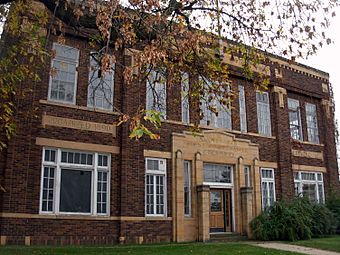Clarks Grove Cooperative Creamery facts for kids
Quick facts for kids |
|
|
Clarks Grove Cooperative Creamery
|
|

The 1927 Clarks Grove Cooperative Creamery from the northeast
|
|
| Location | Main Street East & Independence Avenue, Clarks Grove, Minnesota |
|---|---|
| Area | Less than one acre |
| Built | 1927 |
| Built by | James Nelson |
| Architect | Carl H. Buetow and C. Kampfer |
| NRHP reference No. | 86000480 |
| Designated | March 20, 1986 |
The Clarks Grove Cooperative Creamery is a special old building in Clarks Grove, Minnesota. It was one of the very first cooperative creameries in Minnesota, started way back in 1890. A creamery is a place where milk is processed, usually into butter or cheese.
This creamery used new technology and a smart cooperative system. It became a great example for the dairy industry in Minnesota. Just ten years later, there were over 550 cooperative creameries across the state!
The first building burned down. A new one was built in 1927. This new building had a meeting hall on the second floor. This building is still standing today. It was added to the National Register of Historic Places in 1986. It's important for its history in farming, business, and how people lived together. It also shows how important the small community of Danish Americans was to dairy farming in Minnesota.
Contents
Why Cooperatives Mattered
In the 1870s and 1880s, farmers in southern Minnesota started changing their wheat fields into dairy farms. But making butter on the farm was hard work. It took a lot of time, mostly done by women. Also, many people didn't like farm butter. It often tasted like other foods from the farmer's kitchen.
A New Idea from Denmark
In 1884, a farmer named Hans Peter Jensen visited Denmark. He came back to Minnesota with a great idea for a cooperative creamery. In Denmark, Jensen learned about new ways to make butter. These new methods could change the dairy industry in Minnesota.
However, these new technologies were expensive. It was hard for individual farmers to get them. Most Minnesota farmers had only about a dozen cows. Small dairy farms were not making much money.
How Cooperatives Helped Farmers
Cooperatives, often called "co-ops," helped farmers by combining their resources. Farmers would bring their milk to the co-op. At the co-op, butter was made in large amounts. They used new machines that could separate cream from milk.
Cooperative farmers benefited from the factory's efficiency. They shared the profits and losses with each other. This was different from sharing with outside investors.
Clarks Grove's Big Impact
The Clarks Grove Cooperative Creamery became a model for the rest of Minnesota. It became famous because of Theophilus Levi (T.L.) Haecker. Haecker was a dairy science professor at the University of Minnesota. People called him the "Father of Minnesota Dairying."
Spreading the Word
In 1892, Haecker traveled around Minnesota. He visited many creameries. He was not happy with the poor conditions he found. But when Haecker saw the Clarks Grove creamery, he was very impressed.
He started giving talks all over the state. He told farmers about the good ideas used at the Clarks Grove creamery. In 1894, he wrote a popular guide. This guide showed farmers how to start their own cooperative creamery. It was based on the rules and plans of the Clarks Grove co-op.
Growth of Dairy Cooperatives
With Clarks Grove as an example, cooperative dairying grew quickly in Minnesota. By 1898, there were over 550 cooperative creameries in the state. Minnesota became known for its butter. It also became known for its cooperative farming system.
By 1928, almost half of all cooperative creameries in the United States were in Minnesota. This included important groups like the Minnesota Co-Operative Dairies Association (started in 1911). It also included Land O'Lakes, Incorporated (started in 1921).
A Community Hub
The Clarks Grove creamery was also very important for the local area. It was the first building and the first business in the Clarks Grove community. In the early 1900s, the cooperative grew. It added a cooperative grain elevator, a general store, and a lumber yard.
For many years, the creamery was a community center. It hosted talks, meetings, and school shows. In 1956, it even became a temporary school. This happened after the local schoolhouse burned down.
Creamery Closes
In 1996, the Clarks Grove Cooperative Creamery closed. As dairy farmers retired, there was no longer a need for the co-op.



